Guernsey Motors/Railways Fleet Number 77
Guernsey Motors/Railways Fleet Number 77
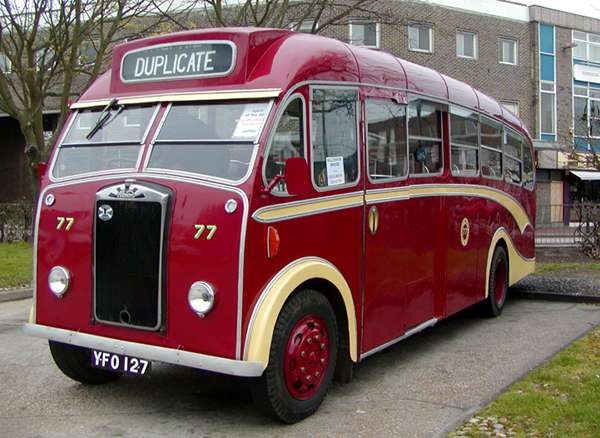
A 1958 Albion Victor FT39KAN with a Reading FB35F body Registration 8226 - YFO 127
Guernsey fleet number 77, an Albion Victor followed a string of Albion's supplied to Guernsey Motors and Guernsey Railway. Designed externally to look like coaches they are in fact buses, Licensed to carry 35 seated passengers and 7 standing, 27ft long and with a width limit of just 7ft (2.15mts) passengers were soon in "close contact" with their fellow travellers!
The engine a four cylinder Albion Diesel proved to be reliable, powerful for its size and economical (12 to 16mpg). The chassis has the benefit of being a straight ladder section design and as a result it was simple and strong. Ideal for Albion in that it was less costly to build and could be used as the basis for both bus and commercial vehicles. The rear wheels are driven by an overhead worm drive differential. The five speed constant mesh crash gear box is a delight, the gearstick is light to move, close at hand, precise and has a relatively short travel. The Victors were not fitted with overdrives and depending on rear axle ratios the top speed varies from 34 to 48 mph. 77 was originally fitted with a low ratio axle, 34mph, however during Brian Catchpoles ownership in the 1980's and 90's an ex Harrods van mid range axle was installed, 40mph! Magic! The KAN chassis as distinct to the earlier Victor AN chassis was given an up rated engine, brakes and road springs.
Red and White of Chepstow took over the Guernsey Railway in 1949 and Guernsey Motors in 1951. Red & White were associated with the Albion agents "Watts of Lydney" and henceforth Albion was the preferred supplier. A total of 39 Albion Victors were added to the fleet the last in 1958. The Albion Victor chassis was designed as a rugged and lightweight chassis aimed at UK mainland rural bus operations and the overseas market. The body was designed specifically by Mr. J.A. Davies, the Guernsey Railway Co. Managing Director. J.A.Davies had come from the Newbury & District Bus Company, a company owned by Red & White Mr J.A.Davies was impressed with the external appearance of their late 1930's Duple bodied coaches.
Guernsey operated school, private hire, service, and island tour schedules and wished to imply to its travellers, tourists in particular that it operated a fleet of luxury coaches. With this in mind and J.A.Davies preference for the Duple style, the Guernsey body naturally followed the Duple Vista outline, but with bus instead of coach seats. This reduced the number of vehicles required and significantly improved the flexibility of the fleet. Interestingly the Duple Vista bodies J.A.Davies saw were essentially of pre-war design starting life in 1936.
The dual purpose Heaver body's appearance hardly changed from 1950 to 1958. In 1956 Heavers stopped supplying the wooden framed composites bodies and changed to an all aluminium framed body designed by the British Aluminium Company, there were many minor changes but the most obvious was the loss of the inset windows and flared lower panels resulting in a completely flat side. In 1957 Heavers ceased trading and "Reading and Company" of Hilsea near Portsmouth started manufacturing the same design bodies for Guernsey, Readings continued to supply the same body until the last Albion had entered service in late 1958, However a similar style of body was constructed until 1973 on the Nimbus and Bedford J4 chassis the very last being made by Sparshatt's of Southampton.
I purchased six Albion Victors from the company at the St Peter Port auction in 1980, five for friends and number 77 for myself. A challenging exercise, three friends came with me and enough batteries for one bus. The buses came back in threes, three by the roll on roll off Channel Islands Ferry and three as freight on the Commodore Clipper where they were stowed below decks and craned off in Portsmouth. 77 came on the roll on roll off service with the only set of batteries, the other two buses being" Tow Start Only". Our arrival at Portsmouth in the dark involved driving 77 out of the ship, turning round and returning on ship to tow start the other two buses in reverse (We could only tow from the front of the buses ie nose to nose), not a popular move with Chanel Island Ferries. All was not over as I had purchased all the Albion spares from the company, these were in twenty five Jonny Walker boxes with the lids stuck down. Initially the customs officer's eyes bulged with excitement, however some hours later we were "released" leaving a very disappointed Customs man on the quay side
In 1981 I realised that owning three Victors (JMT 10 and NKO 953 Fuggles) and only having garage space for two was a disaster in the making and 77 was sold to Brian Catchpole. Brian obtained an early EN286 engine that had not been used, but required attention, he rebuilt the engine, re-panelled and re-painted the bus and looked after it until the turn of the century.
Finding empty space in my the garage enabled me to buy back 77 and use it for another five years, this included using it to transfer the wedding guests to and from the church when I got married. The arrival of a 1944 6X6 GMC truck put space at a premium and something had to go so the Albion passed on to Martin Willetts.
In two thousand and nine, I had regained a bus space in the garage and coincidently Martin wanted to sell the Albion! You have guessed it, I purchased the bus for the third time. A new ceiling, a rebuild of the rear mudguards the fitting of a new set of injectors, a new coat of paint, the reinstatement of the life guards and the original go faster stripes has put the bus back on the road again looking much as it did originally. The bus is now used on the occasional free bus service and to visit places of interest with friends and family.
For the purist 77 was supplied new in red and marked up as Guernsey Motors, it remained red for all it life but was moved from the "Motors" fleet to the "Guernsey Railways" fleet in the 1960's. It now appears as a "Railways" bus
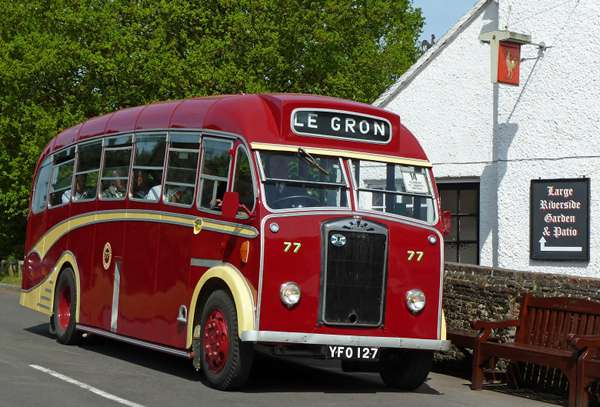
The Guernsey Albion's are a preservationists delight, virtually no wood to go rotten, only two steel panels to go rusty on the body, booking in at four tons ULW its relatively easy to work on, One person can easily take the cylinder off and change the engine if need be. Economical 14 to 15 mpg on long runs and 12 mpg n locals. Only 7ft wide but still carrying 35 passengers. Half drop windows, an art décor interior and almost pre-war body adds up to a very period bus with a unique appearance.
I could of course be biased having owned at one time or another.
| 1559 | 1937 ex The Grays, Guernsey |
| KCD 697 | 1949 ex St Dunstans and Hovis |
| 6436 | 1950 Guernsey 36 a bus that was cut in half and converted to a breakdown vehicle |
| NKO 953 | 1950 ex Fuggles |
| 6442 | 1954 Guernsey 52 |
| 804 FUF | 1954 Ex Jersey Motor Transport 10 - J 15213 |
| 8227 - JPA 83V - (YFO 127) | 1958 Guernsey 77 |
I was also fortunate in being able to "rescue" another six Guernsey Victors by purchasing and importing the buses on behalf of friends. They were all Guernsey Albion Victors.
| UK Reg | Guernsey reg | Fleet no |
| DS 6468 | 6173 | 63 |
| JPA 81V | 4029 | 73 |
| JPA 82V | 4022 | 72 |
| JPA 83V - YFO 127 | 8227 | 77 |
| JPA 84V | 8228 | 78 |
| JPA 85V | 8226 | 76 |
| JPA 86V - 842 FUF | 6768 | 66 |
You may ask what happened to JPA 83Vs Registration number and JPA 86V's? My bus now
YFO 127 was initially issued with JPA 83V and Brian Catchpole obtained the age related number, Noel Marshall did the same with 66.
In 1980 age related registration numbers were almost unheard of, and Surrey would only allocate suffix lettered registration numbers appropriate to the year of importation. The issue was further complicated in that I insisted the buses were issued with six digit reg. numbers to fit into the rear number plate box the modern seven digits were too long. I had to wait some three months for the JPA sequence to start. Eventually the Road Tax Office called to advise "Apply Now" we are issuing the JPA numbers. (No DVLA in those days)
Further history and Information on Guernsey and its buses can be found in two very comprehensive books "Guernsey Bus and Coach Fleet History" and "A History of Guernsey's Buses, Coaches and Trams" both by John Carman.
Peter Davies
02/2014
09/02/14 - 08:15
My attention was caught by Peter Davies`s post of Guernsey Motors No 77 and I send you a few of my old slides from my first visit to the island in 1971 (flew by Vickers Viscount from East Midlands Airport).
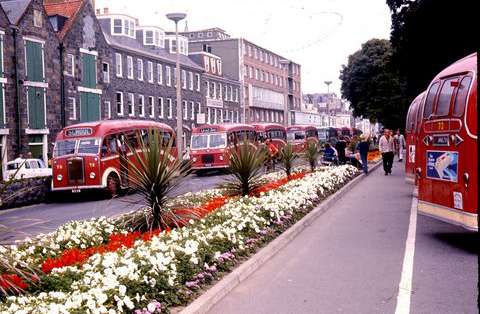
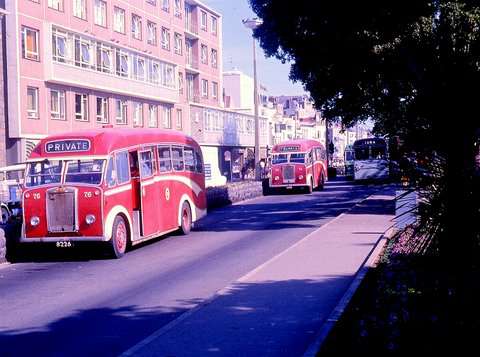
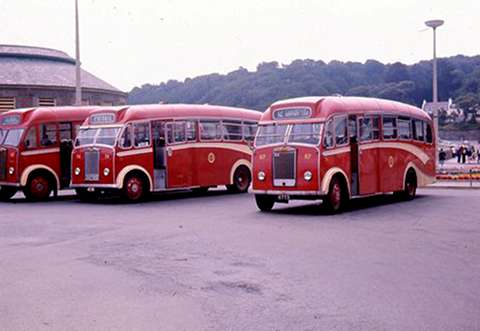
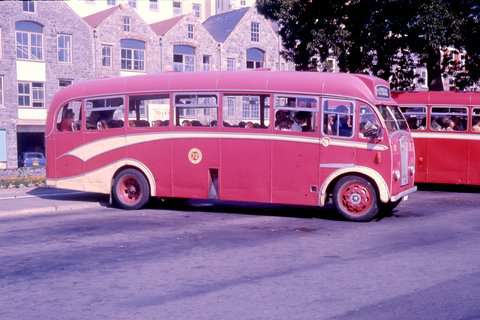
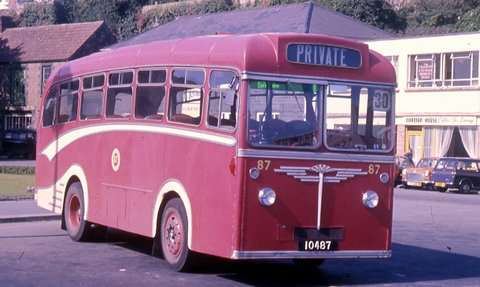
A selection of views and I think among these are a good cross-section of the public transport on offer, I well remember being captivated by the retro charm of the island buses. and how they met the dimensional challenges of the island roads.
Rob Hancock
Comments regarding the above are more than welcome please get in touch via the 'Contact Page' or by email at obp-admin@nwframpton.com
If you have a bus related article that you would like to appear on this site please get in touch via the 'Contact Page' or by email at obp-admin@nwframpton.com
All rights to the design and layout of this website are reserved
Old Bus Photos from Saturday 25th April 2009 to Wednesday 3rd January 2024